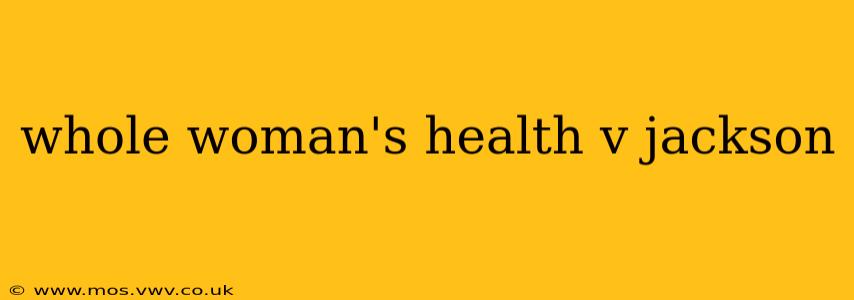Whole Woman's Health v. Jackson: A Landmark Ruling on Abortion Access
The Supreme Court case Whole Woman's Health v. Jackson (2021) stands as a pivotal moment in the ongoing legal battle over abortion access in the United States. This landmark decision significantly impacted reproductive rights and foreshadowed the overturning of Roe v. Wade the following year. Understanding this case requires examining its context, the ruling itself, and its lasting consequences.
What was the central issue in Whole Woman's Health v. Jackson?
The core issue in Whole Woman's Health v. Jackson revolved around Texas's Senate Bill 8 (SB 8), a law that prohibited abortions once cardiac activity was detected in a fetus, typically around six weeks of gestation. Crucially, SB 8 didn't empower state officials to enforce the ban; instead, it allowed private citizens to sue abortion providers and anyone who "aids or abets" an abortion after that point. This unique enforcement mechanism was a key element of the legal challenge.
How did the Supreme Court rule in Whole Woman's Health v. Jackson?
The Supreme Court, in a 5-4 decision, allowed SB 8 to remain in effect, despite the obvious violation of Roe v. Wade's established precedent protecting abortion rights. The majority opinion argued that the unique enforcement mechanism of SB 8 presented jurisdictional challenges that prevented the Court from intervening at that stage. The dissenting justices vehemently disagreed, highlighting the law's clear intent to undermine abortion access and the Court's failure to protect constitutional rights.
What were the consequences of the Whole Woman's Health v. Jackson decision?
The Whole Woman's Health v. Jackson ruling had far-reaching consequences:
- Erosion of Roe v. Wade: The decision effectively gutted Roe v. Wade's protections by allowing a state to circumvent federal court oversight through a novel enforcement mechanism. This paved the way for the eventual overturning of Roe v. Wade in Dobbs v. Jackson Women's Health Organization.
- Increased Restrictions on Abortion Access: The ruling emboldened other states to enact similar restrictive abortion laws, severely limiting access to abortion care, particularly for those in marginalized communities.
- Legal Challenges: The decision led to numerous legal challenges across the country, highlighting the ongoing struggle to maintain reproductive rights.
What are the arguments for and against the Whole Woman's Health v. Jackson ruling?
Arguments against the ruling: Critics argue that the decision allowed a state to effectively nullify a constitutional right through a procedural loophole, undermining the rule of law and disenfranchising women. They maintain that SB 8 was designed to restrict abortion access, regardless of its unusual enforcement mechanism.
Arguments for the ruling: Supporters claim that the decision was based on a narrow interpretation of jurisdictional issues, and not on a rejection of the underlying principles of Roe v. Wade. However, this argument fails to acknowledge the clear impact of the ruling on abortion access.
What impact did this ruling have on women's health?
The ruling drastically impacted women's health, leading to:
- Reduced access to safe and legal abortion: Many women were forced to travel long distances or seek out unsafe, illegal abortions, posing significant risks to their health and well-being.
- Increased health disparities: The ruling disproportionately affected women of color and low-income individuals, who already face barriers to accessing healthcare.
- Increased psychological distress: Restrictions on abortion access can lead to significant mental health consequences for women.
What is the ongoing impact of Whole Woman's Health v. Jackson?
The decision's legacy extends beyond the overturning of Roe v. Wade. It exposed vulnerabilities in the legal protection of reproductive rights and highlighted the ongoing battle to ensure equal access to healthcare for all women. The case serves as a stark reminder of the importance of continued advocacy and legal challenges to protect reproductive freedom. The future of abortion access in the United States remains deeply uncertain in the wake of this pivotal ruling.
